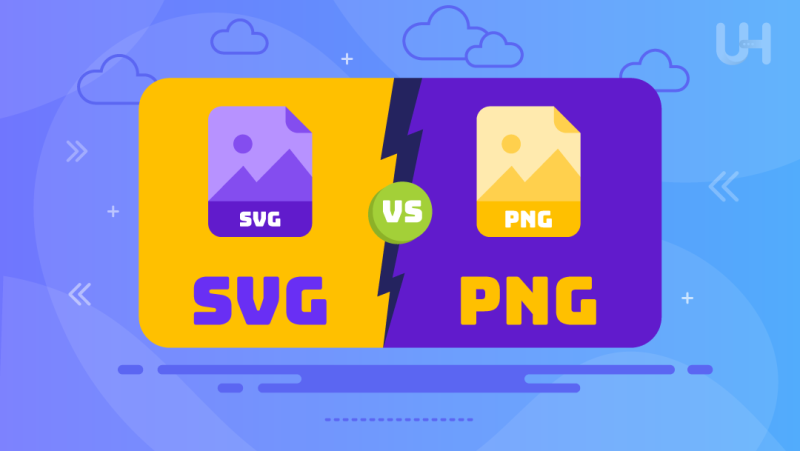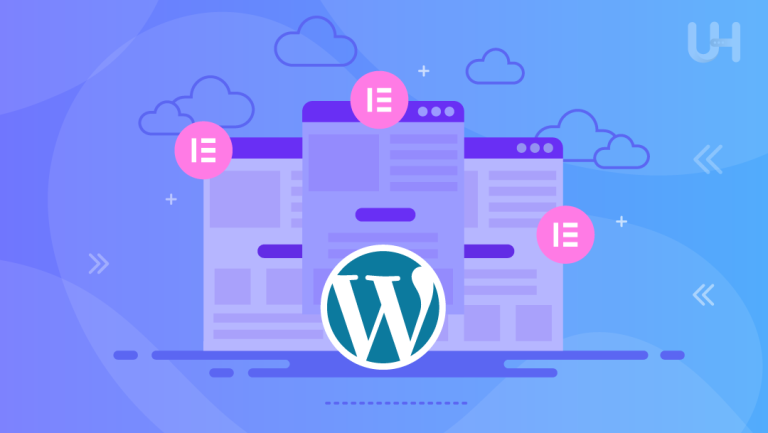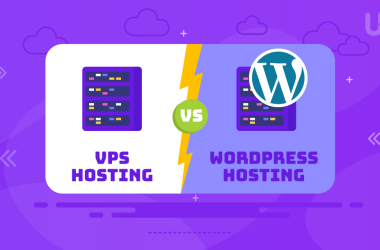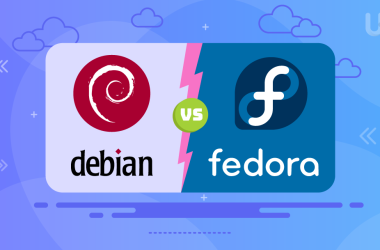PNG and SVG are the recommended file types for saving high-quality graphics or digital logos. They are both scalable formats and support high-resolution displays on a large scale, making them ideal for responsive web designs. In this article, we learn the basics, explore the differences, and identify the best use cases for each, so you can finally answer the question: SVG vs PNG – Which is better?
There are dozens of image file types, each with unique compression types, browser support, and formatting. But PNG vs SVG are two of the most popular file formats as they offer several benefits, as we will see below. The formats are as different as chalk and cheese and are best suited for specific tasks. So, let’s walk you through each in a bit more detail.
What is SVG?
SVG or Scalable Vector Graphics is a widely used vector file format comprising shapes, paths, and texts defined by mathematical equations. They allow SVG images to be scaled up or down without compromising image quality. SVG images are better compressed than bitmap (raster) images and are resolution-independent.
As the images are defined by mathematical equations rather than pixels, the file sizes are smaller than bitmap images, such as PNG. This consumes fewer server resources and optimizes website performance. You can also use a WordPress performance plugin to increase page load speed further for a better user experience.
SVG images can be styled with CSS and scripted with JavaScript, allowing you to create more dynamic and interactive graphics. Therefore, you can change the appearance of an SVG file by simply adjusting the code, instead of creating an entirely new image file. This saves a lot of time and effort for designers and web developers. If you are new to website development, consider using web development tools to streamline your tasks.
Pros
- This is a scalable file format. You can manipulate images with coding and scale the file size up or down without affecting quality.
- They are optimized for speed and consume fewer server resources.
- The SVG format supports animation.
Cons
- You might run into compatibility issues on older browsers and email clients.
- You need specialized tools like Adobe Illustrator to manipulate them, which can be expensive.
- SVGs are difficult to embed on WordPress. You must install a third-party SVG plugin to upload files.
What is PNG?
Portable Network Graphics or PNG is the most common bitmap file format used by designers, photographers, and web developers. Unlike SVG which uses mathematical equations, PNG is made using pixels, which are small blocks of color that assemble to form a picture. PNG images are resolution-dependent, meaning they lose quality when scaled up or down.
PNG images are popular globally due to specific benefits. For example, they support lossless compression, meaning the image quality is not compromised when a file is downscaled. This is useful for images using solid color on vast surfaces, such as icons and logos.
PNG images support transparent backgrounds, which allows designers and web developers to add layers. This is a major advantage over other raster image formats like JPEG or JPG. Furthermore, PNG images are compatible with most web browsers and editing software, which makes them convenient for everyday use.
Pros
- They can be easily edited with any image editor. You don’t need to purchase premium software.
- You can display PNG images on your WordPress website using the default media library. For better presentation, consider using a gallery plugin.
Cons
- The files are generally larger than SVG due to lossless compression. This can increase page load times considerably.
- Since the format is resolution-dependent, you cannot resize PNG images without affecting quality.
Grow Your Business with Managed WordPress Hosting
Take your website to the next level with Ultahost’s LiteSpeed WordPress Hosting Plans and experience up to 5x faster loading times. Our Scalable hosting solutions are precisely built to maximize speed and performance.
PNG vs SVG: Comparing the Key Differences
Here are four primary differences between PNG and SVG file formats.
Image Scaling and Quality
SVG images are vector-based, meaning they can be scaled up or down without compromising image quality. This makes them ideal for responsive website designs where images must adapt to different display resolutions. On the other hand, PNG images are raster-based and lose quality when downscaled. Therefore, web developers must create multiple PNG files to ensure a website’s mobile responsiveness.
Customization and Manipulation
One of the primary differences between SVG vs PNG is that the former is manipulated easily with JS and CSS. You can customize the appearance of an SVG file format by adjusting the code. You don’t have to create a new image file for different display resolutions. This saves time and helps create dynamic and interactive website elements. On the other hand, PNG images are not flexible and cannot be manipulated with coding, So you must create a new image file for different resolutions or convert it to a different file format.

File Size
SVG images are generally smaller than PNG files, especially for simple graphics or icons. This is because mathematical equations occupy less space than pixels. However, SVG is not ideal for storing complex designs or photographs, as the file size may amplify manyfold. Therefore, whether to use SVG vs PNG depends on your situation. We recommend comparing the file sizes before saving your design.
Browser Support
Whether you use SVG or PNG formats in your website will depend on your situation. However, both file types are compatible with modern web browsers. All you need is a reliable managed VPS host for your website. However, kindly note that some old browsers or email clients may not support SVG, PNG, or both. Therefore, you must identify the browsers and platforms where the images will be most viewed and choose a file format accordingly.
SVG vs PNG: Which Should You Use and When?
Whether you choose SVG or PNG, both have their share of flaws. While SVG may outperform PNG in specific areas, the latter has its use. As a rule of thumb, consider using SVGs wherever applicable and PNGs in every other situation where vector files are outmatched.
For example, SVG supports animation whereas PNG does not, which makes it a more practical choice. They are responsive and scale better to fit any display resolution. Furthermore, they are smaller than PNGs and consume fewer server resources, meaning you can rent a cheap VPS to host your website.
PNGs, on the other hand, are ideal for hosting complex graphics, images, or photographs of a larger resolution and pictures with thousands of colors. Since SVGs use mathematic equations instead of pixels to output displays, they can only process limited colors and shapes. Moreover, PNGs are compatible with most web browsers and online platforms like email clients. So, if you want your website to render properly all the time, PNG is the better choice.
Conclusion
SVG vs PNG is a long-standing debate among web developers. They are very different file formats and have specific uses. Knowing when to use which file type is a key part of a web developer’s duty. And we have explained the features, pros, and cons of each to help you make a better choice.
Increase the speed of your WordPress website with Ultahost’s Fast WordPress Hosting and let your visitors enjoy up to 5x more speed for the ultimate website viewing experience. Get ultra-fast servers, NVME SSD storage, unmetered bandwidth, and automatic core updates, starting at just $2.90/month.
FAQ
SVG vs PNG: Which is better?
Both SVG and PNG have their share of uses. You must use a suitable file format depending on your requirements.
Which is the best format for storing vectors?
SVG is the best format for storing vectors. They are lightweight and flexible and can be indexed, searched, and scripted using JavaScript and CSS.
What is the difference between SVG and GIF?
SVG images look crisp on any screen resolution no matter how much you scale it up. GIFs, on the other hand, lose quality when scaled up or down.
When not to use SVG?
SVG is unsuitable for complex visuals, such as photographs with thousands of colors. Raster image formats like PNG or JPEG are a better choice.
What are the disadvantages of SVG?
SVG is unsuitable when an image contains multiple small elements, as it can quickly amplify the file size. Saving the file in PNG format will help you limit the file size.










